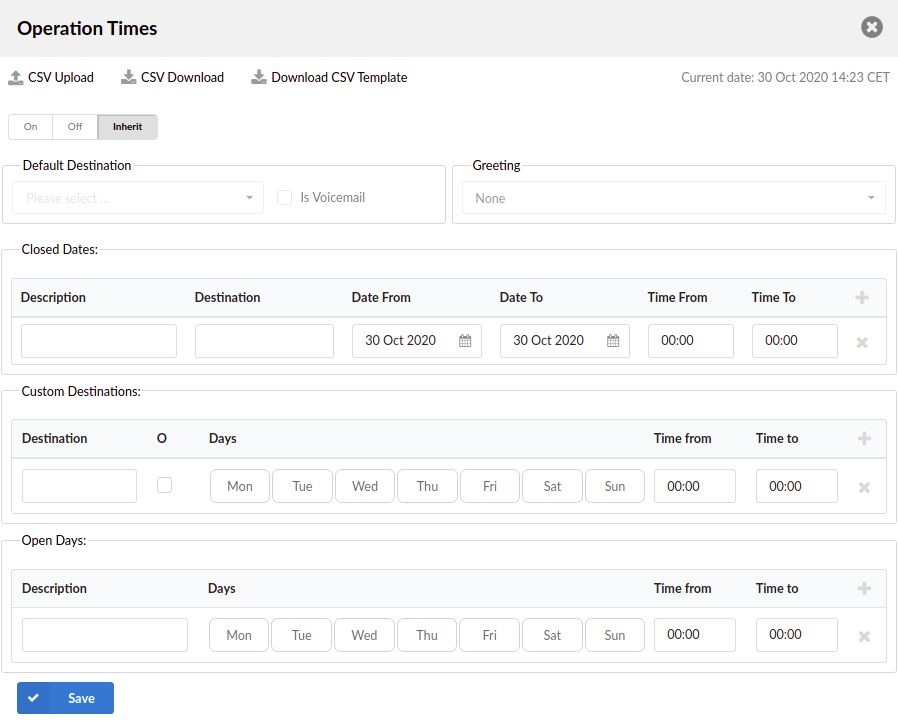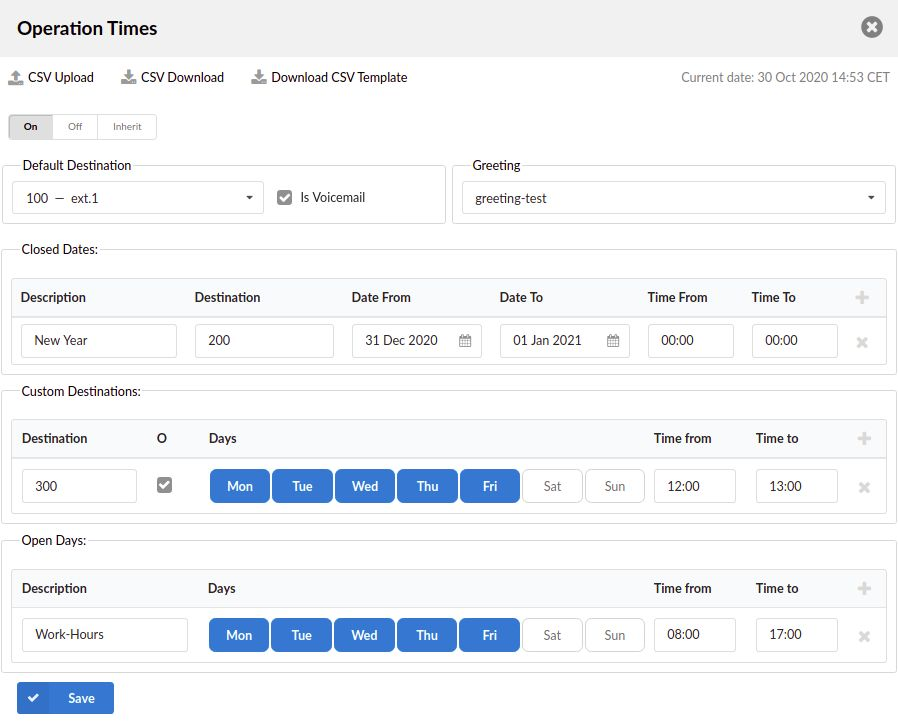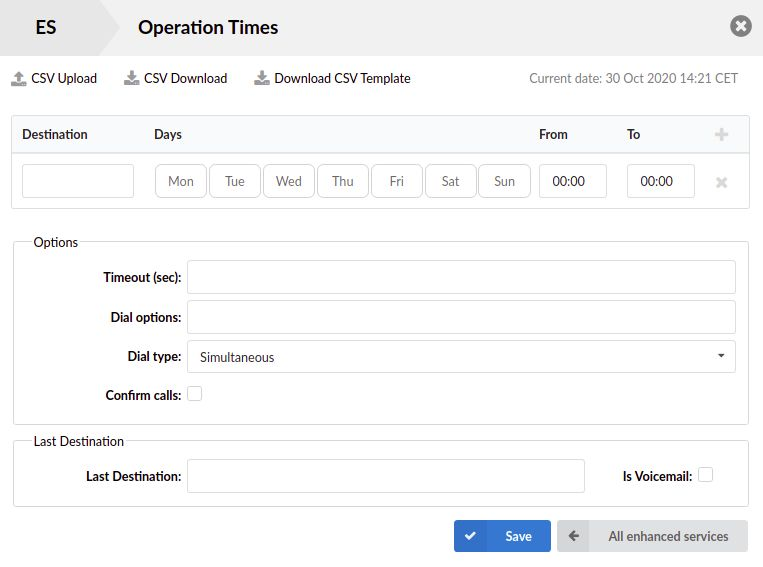Operation Times can be set in several different locations in PBXware. These locations are listed below for both editions:
¶ For Multi-Tenant Edition
On Master Tenant Level:
'Master Tenant' -> 'Master Tenant' (Edit) -> 'General Settings' (section) -> 'Operation Times'
On Tenant Level:
'Master Tenant' -> 'Tenant XXX' (Edit) -> 'General Settings' (section) -> 'Operation Times'
On DID Level:
'Tenant XXX' -> 'DIDs' -> 'Operation Times'
¶ For Contact Center Edition
On Server Level:
'Settings' -> 'Servers' -> Edit 'Server' -> 'General Settings' (section) -> 'Operation Times'
On DID Level:
'DIDs' -> 'Operation Times'
Also, Operation Times can be set on the following destinations:
- Queues
- IVRs
- Ring Groups
- Extensions
NOTE: Since the layout for Operation Times settings is the same for almost every location, this document covers all the required details for the setup. The only difference is the Extension where there are some additional options which will be explained later in the document.
The screenshot below displays Operation Times that can be seen on each of the mentioned Destinations except on the Extension. For more details on how to configure Operation Times on an Extension, please refer to the further text.

- CSV Upload
Click this button to upload Operation Times configuration from a CSV file.
- CSV Download
Click this button to download Operation Times configuration as a CSV file.
- Download CSV Template
Downloading the CSV Template button should provide a file that already contains necessary headers which should help a user while creating CSV files. These can be later uploaded by clicking the ‘CSV Upload’ button.
- Operation Times Active

This option is only available on Master Tenant and defines whether Operation Ttimes will be active or not.
| Options | |
|---|---|
| ON | If selected, Operation Times rules will be applied on this destination in particular. |
| OFF | If selected, Operation Times rules set on this location will not be applied. The calls will go through, if not defined otherwise. |
| INHERIT | If set, Operation Times rules will be inherited from the level above. (For example, if a user sets Operation Times on a Tenant level, those rules will be inherited from the Master Tenant.) |
¶ Default Destination
- Default Destination
Select a Destination to which all calls will be redirected in case the call comes outside the working hours, and if it is not defined otherwise with additional rules available.
- Is Voicemail
If this is checked, a call should go to the voicemail of the predefined Default Destination in case a Default Destination is called.
- Greeting
Choose a Greeting sound file that should be played to callers during the closed dates.
(Example of the file: greeting-***)
.
¶ Closed Dates
This section allows users to set the specific date/s and time when all calls are redirected to the 'Default Destination'.
NOTE: If the 'Destination' field in the 'Closed Dates' is set, all calls will go to the set Destination instead of the default one.
.
¶ Custom Destinations
This section allows users to redirect all calls received during set days/hours (e.g weekend) to the Extension provided as a Destination.
NOTE:
If the 'o' option is unchecked, the greeting configured for Operation Times will be played for all calls that arrive during the time period defined for the custom destinations.
If the 'o' option is checked, calls that arrive during the time period defined for the custom destinations will be redirected to the specified custom destination without playing the greeting.
.
¶ Open dates

This section allows users to set the system's working hours.
If any call is received during the hours that are not defined here, the call will be redirected to the 'Default Destination'.
To better understand all of the mentioned settings, please refer to the screenshot below where all the mentioned fields are populated with examples. Each of the mentioned fields is described accordingly to its functionality.
.
¶ Example Configuration
The screenshot above displays the enabled 'Operation Times' functionality on one of the Destinations. In this case, Operation Times is enabled on the DID level.
As it is shown in the example, if a call comes during working hours, which are set to be from 08:00 until 17:00 o’clock, the call will be routed properly to a dialed Destination.
In case the call comes outside working hours, the call is redirected to the ‘Default Destination’ which, in this example, is Extension 100. Also, since the ‘Is Voicemail’ option is checked, the call would go to the voicemail box of that Extension instead of dialing Extension 100 directly.
Furthermore, if a call comes between 12:00 and 13:00 o’clock, (for example during a lunch break), the call would be redirected to the Destination 300. Also, as the ‘o’ option is checked, the caller would be listening to the greeting that is set in the ‘Greeting’ section.
In case the call comes during mentioned dates set in the ‘Closed Dates’ section, the call would be redirected to the 200 Destination.
.
¶ Access Codes
Managing Operation Times can also be done via access codes.
- Open Operation Times
A user can dial '*401' to open the systems' Operation Times
(E.g. During closed times, users can dial the mentioned access code to open Operation Times and thus become available.
- Close Operation Times
A user can dial '*402' to close the systems' Operation Times
(E.g. During open times, users can dial the mentioned access code to close Operation Times and thus become unavailable, after which the rules set in the Operation Times settings will be applied.)
- Reset Operation Times
A user can dial '*403' to reset the systems' Operation Times and restore the rules entered in Settings.
- Midnight Reset
A user has the ability to set the Operation Times midnight reset option to one of the following options:
| Options | |
|---|---|
| YES | If set, access codes will be reset at midnight. |
| NO | If set, the midnight reset will be skipped. |
| NOT SET | If set, the same action will be performed as if this was set to ‘Yes’ since the midnight reset is enabled by default. |
NOTE: Furthermore, all of the mentioned access codes can be used in combination with a DID in case a user does not want to open/close or reset Operation Times on a global level and wants to do so on a DID level.
(E.g. Dialing “*401+DID” would open Operation Times only for a certain DID. The same applies to other access codes, such as *402 & *403.)
.
¶ BLFs
Some additional settings related to the Operation Times can be set via BLF buttons.
Open/Close: *404
A user can program a BLF key on their phone to *404 in order to monitor the Operation Times status and use it to enable or disable Operation Times rules.
(E.g. If a user stays in the office after the Operation Times rules activate for off hours, the BLF will notify the user of the changed state by turning on the BLF light or changing its color.)
NOTE: This behavior will depend on the device used. *Once *404 is provisioned as BLF, pressing the button will toggle Operation times ON or OFF, in the same way as if a user dialed *401/*402.
Close/reset: *405
To reset Operation Times rules, a user will have to dial *405 manually. Dialling the mentioned access code uses the initial Operation Times settings that were set.
IMPORTANT: System Operation Times ES has to be enabled for this to work.
Furthermore, both mentioned BLFs can be used in combination with a DID in case a user does not want to open/close or reset Operation Times on a global level and wants to do so on a DID level. (E.g. Dialing “*404+DID” would open Operation Times only for a certain DID. The same applies to the other access code: *405.)
.
¶ Operation Times on Extensions
There are few additional options related to Operation Times on an Extension. To set Operation Times on the Extension, a user has to navigate to the following path:
- For Contact Center Edition (Extension)
'Home' -> 'Extensions' -> Edit 'Extension' in question -> 'Enhanced Services' -> Enable 'Operation Times' -> Press 'Save' -> Edit 'Operation Times'
- For Multi Tenant Edition (Extension)
'Tenant' in question -> 'Home' -> 'Extensions' -> Edit 'Extension' in question -> 'Enhanced Services' -> Enable 'Operation Times' -> Press 'Save' -> Edit 'Operation Times'
Please refer to the screenshot presenting how the Operation Times section looks on the Extension.

Enabling Operation Times on an Extension gives users the ability to set different call redirections based on the Operation Times rules that are set. Here, a user can set up a Destination to which the call should be redirected as well as the time and days when to be redirected.
- CSV Upload
Click this button to upload Operation Times configuration from a CSV file.
- CSV Download
Click this button to download Operation Times configuration as a CSV file.
- Download CSV Template
Downloading the CSV Template button should provide a file that already contains necessary headers which should help a user while creating CSV files. These can be later uploaded by clicking the ‘CSV Upload’ button.
- Destination
Set a Destination to which all calls should be redirected throughout the duration of the ‘Close Dates’
- Days
Specify the days during which ‘Operation times’ rules will be applied.
- From
Specify the exact time from which ‘Operation times’ rules will be applied.
- To
Specify the exact time when ‘Operation times’ rules will stop to apply.
.
¶ Options
- Timeout (sec)
Set the timeout that will define the amount of seconds that an Extension will ring before the call is considered as unanswered.
- Dial options
Add the advanced dial options for all incoming calls.
- Dial type
Define whether all Destinations will ring at the same time or one by one.
| Dial Type | |
|---|---|
| Simultaneous | All Destinations will ring at the same time. |
| Sequential | All Destinations will ring one at a time. After the timeout, a call will move to the next Destination in line. |
- Confirm calls
If enabled, users can make sure that the call is answered by a person and not by a voicemail.
(E.g. When picking up the call, a person needs to press ‘1’ (or another key on the phone) to answer the call. If that key is not pressed, the phone will keep ringing because it will be considered unanswered.)
.
¶ Last Destination

- Last Destination
This is the Last Destination that is called if all others from the 'Destination' list do not answer. The Last Destination can also be a voicemail if the option ‘Is Voicemail’ is checked.
(E.g. If this field is set to '100' and none of the Extensions answer, the Extension 100 will be dialed.)
- Is Voicemail
If this option is checked, voicemail will be set as a Last Destination as it is shown on the screenshot.